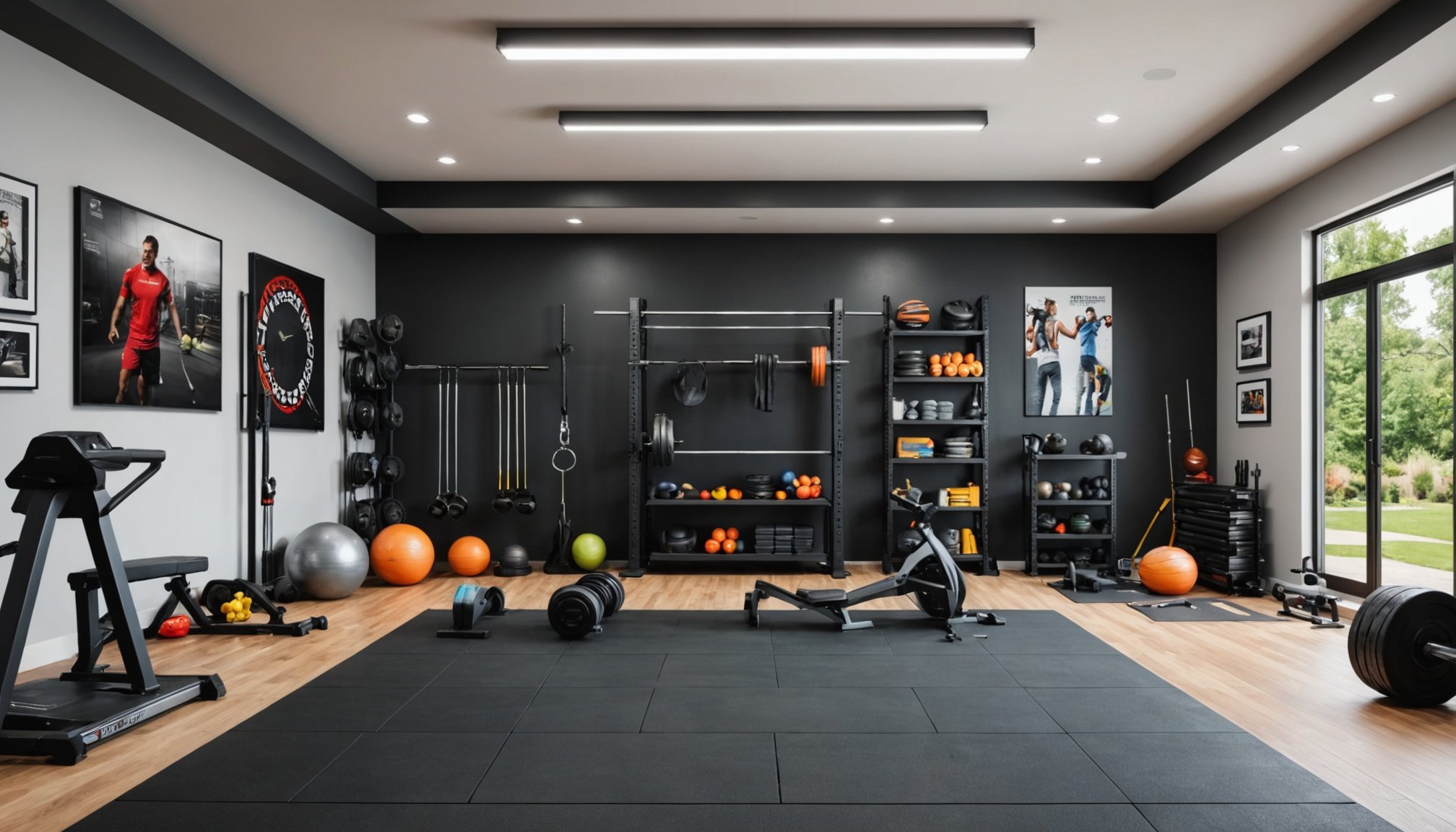Planning Your Garage Space
Transforming a garage into a home gym requires careful garage space optimization. Begin by measuring available space to ensure that equipment fits and allows for comfortable movement. This step is vital in creating a harmonious area that caters to your workout needs.
When considering the layout, designing effective traffic flow and distinct workout zones can significantly enhance your exercise experience. Allocate space strategically for different activities, such as cardio and strength training, to maximise efficiency and minimize disruptions during workouts.
Also read : Transform Your Home Office: Chic and Organized Ideas to Tailor Your Workspace
Maximising vertical space through smart storage solutions not only helps to declutter but also expands the usability of the floor area. Wall-mounted racks and shelves can store essential gear within reach while keeping the floor clear for activities.
In optimising a garage space, integrating creative solutions like foldable equipment or versatile furniture can also help manage limited areas without compromising the gym’s functionality. Investing time in planning a thoughtful layout prevents future hurdles and ensures a smooth incorporation of home gym design.
Also to read : Create a Cozy and Secure Fireplace Sanctuary: Must-Know Design Tips for Family Homes
Understanding the Benefits of a Home Gym
The transition to a home gym brings numerous garage gym benefits, offering a range of advantages tailored to personal fitness goals. One significant benefit is the flexibility and convenience in workout schedules. This enables individuals to exercise whenever suits them best, without the constraints of gym timings.
Establishing a home gym proves cost-effective over time compared to gym memberships. Although the initial investment might seem daunting, the long-term savings are considerable, freeing one from recurrent membership fees. Additionally, there’s less temptation to use costly add-ons like personal trainers or classes, as the focus is purely personal progress.
A home gym also allows for personalization of the workout environment and regimen. This freedom means music, lighting, and even workout styles can be tailored to individual preferences, enhancing motivation and enjoyment. Personalisation fosters a positive workout mindset, making exercise something to look forward to rather than an obligation.
Moreover, having a fitness at home setup eliminates many logistical barriers to regular exercise. No commute means more time for other activities and less stress, firmly positioning a home gym as an advantageous asset for achieving consistent and rewarding fitness experiences.
Essential Equipment for Your Home Gym
Creating an effective home gym means selecting the right home gym equipment and fitness gear for your needs. With a wide range of workout tools available, it’s crucial to make choices that benefit your fitness goals and fit within your allocated space.
Cardio Equipment
For cardio, options like treadmills and stationary bikes provide diverse workout experiences. Treadmills offer a natural running feel, adjustable inclines, and can often be folded to save space. Stationary bikes, particularly compact models, are great space-saving solutions for small garages, offering a convenient cardio option without compromising performance. Brands such as Sunny Health & Fitness provide budget-friendly options without sacrificing quality.
Strength Training Gear
A well-rounded strength-training setup requires essentials like dumbbells, kettlebells, and benches. Adjustable dumbbells save space and accommodate varying weight preferences. Kettlebells add versatility for dynamic workouts. Additionally, incorporating multi-functional equipment, such as power racks or resistance bands, allows for a wide range of exercises without needing multiple tools.
Accessories and Extras
Additional workout tools like mats ensure comfort during floor exercises, while mirrors assist with form-checking. Safety equipment like clips for weight bars prevents accidents. To enrich your workout, consider tech gadgets like fitness trackers or sound systems to maintain motivation.
Designing Your Home Gym Aesthetics
Creating an inviting home gym design goes beyond just assembling equipment; it encompasses crafting an atmosphere conducive to your fitness journey. Selecting a motivating colour scheme can transform your workout space. Vibrant hues like blues and oranges energise the environment, while neutral tones provide a calming backdrop.
Lighting Options
Proper lighting is crucial in a garage gym. Natural light sources, such as windows or skylights, enhance the mood, but if those are unavailable, consider adding bright, adjustable LED lights. These options provide adequate illumination, supporting both productivity and safety during workouts.
Personal Touches and Inspiration
Incorporating personal elements into your home gym decor can significantly influence motivation. Inspirational posters, a dedicated music corner, or displaying fitness milestones personalise the space, making it uniquely yours. These touches not only boost morale but also foster an engaging and inviting atmosphere that encourages regular exercise.
An aesthetic that resonates with you enhances your overall fitness at home experience. Tailoring these elements ensures your home gym remains a place where progress and enjoyment go hand in hand, paving the way for sustained commitment to your workout regimen.
Budgeting for Your Home Gym Transformation
Establishing a home gym budget is crucial for ensuring a seamless transformation of your garage into a personal fitness haven. Start by conducting a thorough cost analysis to compare the expenses related to purchasing equipment with potential renovation costs. Consider how adaptable your space is—some garages might require more substantial alterations to suit their new function.
Investing in quality home gym equipment upfront can prevent future replacements and repairs, but savvy shoppers may find valuable options by exploring second-hand or discounted equipment. Local classifieds, online marketplaces, and garage sales are excellent starting points for budget-friendly options. Remember to factor in ongoing expenses like maintenance, utilities, and occasional upgrades to keep your gym functional and enjoyable.
Financial planning doesn’t stop at the initial setup. Anticipating costs for repairs, equipment replacement, and increasing utilities can prevent budgetary surprises down the road. By thoughtfully mapping out anticipated expenses, you’ll ensure your home gym remains a sustainable and cost-effective investment. Prioritise essentials and pace your spending to avoid unnecessary debt, gradually enhancing your setup as resources allow. This strategy ensures your commitment to fitness doesn’t falter due to financial strain.
Troubleshooting Common Garage Gym Challenges
Effectively managing garage gym challenges is crucial for maintaining a consistent workout routine. Addressing potential space constraints is a common hurdle. Optimising layout with multi-functional equipment and wall storage can alleviate clutter, ensuring both safety and convenience.
Temperature and humidity in the garage can impact workout comfort and equipment longevity. Installing insulation, dehumidifiers, or portable heating and cooling units provides temperature control. These solutions help create a stable environment conducive for exercise, regardless of external weather conditions.
Staying motivated and maintaining workout consistency is another key challenge. Establishing a regular schedule and setting clear fitness goals can transform your garage into a motivating space. Incorporate variety into workouts to keep your routine engaging; alternate between cardio and strength training to suit different moods and energy levels.
Additionally, create an inspiring atmosphere with uplifting music or podcasts. This personal touch encourages routine workouts by enhancing the overall experience. By proactively addressing these common challenges, you not only maintain a functional environment but also ensure your home gym remains an inviting and productive space.
Before-and-After Case Studies
Exploring transformation stories of garages into functional gyms provides valuable insights and inspiration. These garage gym examples showcase real-life conversions, highlighting the remarkable changes achieved with thoughtful planning and resourcefulness.
Case Study 1: Sarah’s Yoga Retreat
- Sarah transformed her cluttered garage into a serene yoga studio.
- Utilising soft lighting and calming hues, she created an inviting space, perfect for meditation.
- Key takeaway: Focus on design elements that support the intended workout type.
Case Study 2: Mike’s Strength Zone
- Mike maximised his limited garage space with vertical storage and foldable racks.
- His setup supports intense weightlifting sessions without sacrificing functionality.
- Key takeaway: Use smart storage solutions to maintain efficiency.
Case Study 3: Emily’s Cardio Corner
- Emily incorporated compact, budget-friendly equipment for a cardio-focused gym.
- The addition of mirrors and strategic lighting enhanced her workout environment.
- Key takeaway: Prioritise equipment that aligns with specific fitness goals.
These transformation stories illustrate that with proper planning, even the most unassuming garage can become a fitness haven. By learning from these real-life experiences, individuals can draw inspiration, applying key lessons to craft their own ideal workout environments at home.
Shopping List and Resources
When establishing your home gym, crafting a comprehensive equipment shopping list aligns with budget and fitness goals. Identifying the right home gym resources is crucial for creating an effective workout space tailored to your unique needs.
Start with essential categories:
- Cardio gear: Consider compact treadmills or stationary bikes for efficient calorie burning without overloading your garage floor space.
- Strength tools: Basic adjustable dumbbells, resistance bands, and durable yoga mats offer flexibility in various training regimens.
- Accessories: Proper lighting, mats, and mirrors are vital for creating a functional atmosphere. Adding elements like sound systems can enhance your workout experience.
Where to buy? Online platforms often provide a broader selection of both new and second-hand equipment. However, local stores can offer direct interactions and quicker exchanges, ensuring satisfaction and convenience.
Leveraging trusted fitness guides and reviews helps when selecting brands and equipment. Continued research via reliable sources provides updated insights, especially if fitness at home trends evolve. Use trusted forums or online communities for genuine product feedback and recommendations. Integrating these resources fortifies your home gym investment, helping maintain fitness motivation through informed and strategic planning.








